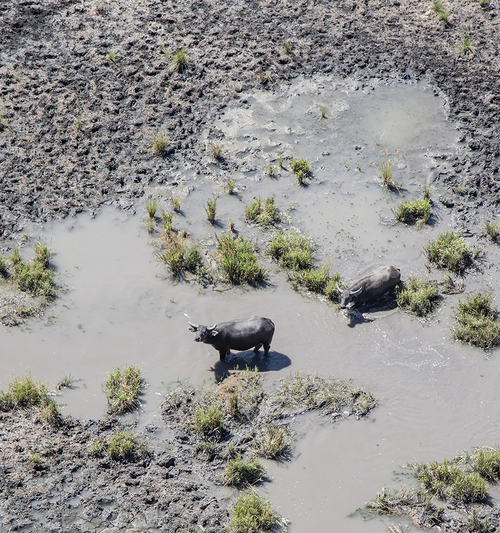
Feral Animal Management
Fighting feral animals and disease
Land managers all over Australia are struggling to find ways to reduce populations of feral animals - from pigs and cats to big herd animals like buffalo, cattle, horses and donkeys.
Better management of ferals will reduce the threats of erosion, damage to fresh water areas and the spread of weeds. There are no simple and effective solutions, but our rangers are developing the knowledge and skills to use tools that are available to map where most damage is occurring and target places of most concern. Because the problem is so big, we focus on the worst affected areas. Freshwater places where we have springs, creeks and wetlands areas are most affected by the pests and removing ferals is an important part of our project to improve our freshwater. We are growing our skills in building and managing animal traps and using safe baiting techniques. Until we know more about how to control feral animals more efficiently, we are also investing in training our rangers to be skilled and qualified marksmen.
Many national parks and conservation friends try to get rid of all big, grass-eating herd animals. However, more than 20 years catching ferals like buffalo has created seasonal jobs and royalty money for some clans. That’s good for our local economy. We’re working to find ways we can work with landowners and commercial companies so we can continue to get economic benefits while improving management and reducing damage. Mimal wants to help landowners get the right balance between caring for country, making money and creating more jobs on country.
We share the concerns of all landowners for the early detection of diseases that may threaten animal and human populations. Mimal Rangers, like many remote ranger groups, are in a strategic position to provide cost-effective monitoring for such diseases. Partnerships, special training and fee-for-service contracts with Biosecurity Australia benefits local people and the nation. Older Mimal Rangers have quite a lot of experience in biosecurity work and they‘re helping to pass on that knowledge.
Buffalo: Buffalo make a big mess in and around water, fishing and hunting places. Many people have told us buffalo also stop them from using special places for hunting because they are frightened of cheeky buffalo. One of our rangers doing early burning had a lucky escape when chased by a buffalo in 2016.
Horses and Donkeys: Horses and donkeys have been on our lands for a long time. We have grown up seeing them as part of the country. But when there are too many they can damage some country very badly. While less damaging than buffalo, horses and donkeys do harm the landscape and help to spread invasive weeds.
Feral Pigs: Pigs are badly damaging freshwater areas. They wallow and root around the edges of creeks, swamps, billabongs and springs, fouling the water and destroying the vegetation that prevents erosion and provides food and nesting sites for native wildlife. Pigs spoil our special places, our sources of fresh water and make us feel unsafe when we want to take families camping and fishing on country.
Feral Cats: Wild cats are a very big threat to our native birds and small animals. They love to hunt on plains country and will travel long distances to follow fire as they hunt. In many places small animals like bush mice and rats have disappeared altogether. Cats kill our blue tongues and other lizards. We can use camera traps to monitor numbers and use satellite-tracking collars to monitor their movements, but little is known about how to make a big reduction in their population. Some groups have trialled fences to create cat-free areas and scientists are investigating if dingoes scare cats away.

